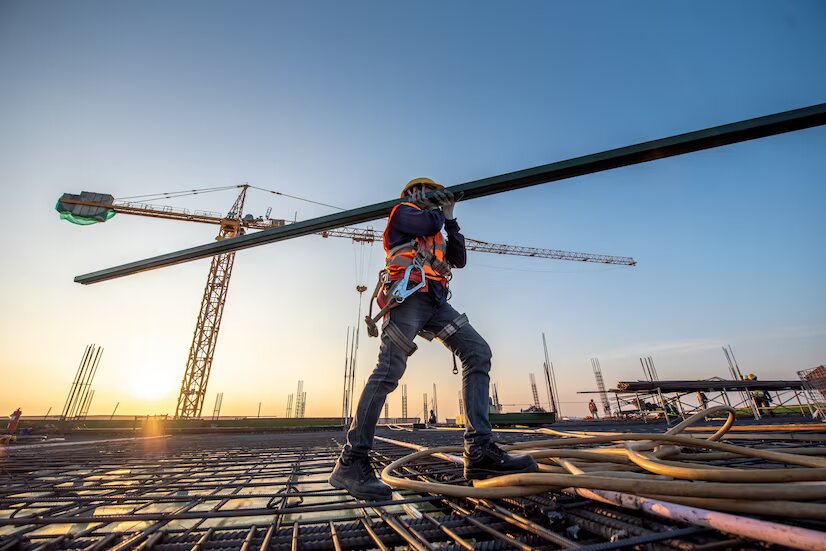Table Of Contents
The Top 10 In-Demand Construction Jobs For 2023
Last Updated on: September 20th, 2024
The construction industry plays a vital role in the global economy, contributing to the development of infrastructure, housing, and commercial buildings. It is a vast industry that employs millions of workers worldwide, offering a wide range of career opportunities for those interested in pursuing a career in this field.
Construction jobs are crucial to the economy, as they not only provide employment opportunities but also contribute to the growth of local and national economies. The industry generates billions of dollars in revenue annually and supports various sectors, such as manufacturing, transportation, and retail.
As we look forward to the coming year, we can expect the construction industry to continue to grow and thrive. The demand for construction jobs is expected to rise in 2023, with a particular focus on certain professions.
In this blog post, we will take a closer look at the top 10 in-demand construction jobs for 2023. These jobs offer great career prospects, high earning potential, and exciting opportunities for those looking to enter the industry. Whether you are a seasoned professional or a new entrant to the field, these jobs provide a wealth of opportunities for growth and advancement. So, without further ado, let’s dive into the top 10 in-demand construction jobs for 2023!
1. Construction Manager

Construction managers oversee the construction jobs from all aspects of a construction project, from planning and design to construction and completion. They play a critical role in ensuring that projects are completed on time, within budget, and to the satisfaction of clients.
A. Responsibilities Of A Construction Manager
One of the primary responsibilities of a construction manager is to plan and coordinate all aspects of a construction project. This includes developing project timelines, creating budgets, and hiring and managing subcontractors and construction workers. They also work closely with architects, engineers, and other professionals to ensure that the project is designed to meet the client’s needs and specifications.
B. Educational Requirements And Experience Needed
To become a construction manager, a bachelor’s degree in construction management, engineering, or a related field is typically required. Many employers also prefer candidates with several years of experience working in the construction industry, as well as professional certifications, such as the Certified Construction Manager (CCM) designation.
C. Job Outlook And Salary Range
According to the Bureau of Labor Statistics (BLS), the construction jobs outlook for construction managers is excellent, with a projected job growth of 10% from 2020 to 2030. As of 2021, the median annual salary for construction managers is $97,180, with top earners making over $165,000 per year.
2. Civil Engineer
Civil engineers are essential members of the construction industry, responsible for designing and overseeing the construction jobs of infrastructure projects such as roads, bridges, airports, and water treatment plants. They use their knowledge of physics, math, and materials science to design and supervise the construction of safe, efficient, and sustainable structures.
A. Role Of Civil Engineers In The Construction Industry
One of the primary roles of civil engineers in the construction industry is to design and plan construction projects. They work with architects, contractors, and other professionals to ensure that projects are designed to meet the client’s needs, budget, and safety standards. Civil engineers are also responsible for ensuring that construction jobs projects comply with local and federal regulations and are built to last.
B. Educational Requirements And Experience Needed
To become a civil engineer, a bachelor’s degree in civil engineering or a related field is typically required. Many employers also prefer candidates with a master’s degree in civil engineering, as well as several years of experience working in the construction industry. Professional licensure is also required for civil engineers, which typically involves passing an exam and meet education and experience requirements.
C. Job Outlook And Salary Range
The BLS predicts a 2% increase in demand for civil engineers between the years 2020 and 2030, which is much higher than the average for all occupations. The average salary for a civil engineer in 2021 is $88,570 per year, with the highest 10 percent earning more than $144,560.
3. Architect
Architects are vital members of the construction industry, responsible for designing and planning the layout, functionality, and aesthetics of buildings and structures. They work with clients, construction jobs for professionals, and engineers to develop innovative and practical design solutions that meet the needs and budget of the project.
A. Role Of Architects In The Construction Industry
One of the primary roles of architects in the construction industry is to create detailed plans and designs for buildings and structures. They use their knowledge of engineering, math, and art to develop plans that meet the functional and aesthetic needs of the project while also complying with local and federal regulations.
Architects are also responsible for overseeing the construction jobs and their overall processes to ensure that the design is implemented correctly.
B. Educational Requirements And Experience Needed
To become an architect, a bachelor’s or master’s degree in architecture is typically required. Many employers also prefer candidates with several years of experience working in the construction industry, as well as professional licensure.
Professional licensure for architects involves passing an exam and meeting education and experience with the construction jobs requirement.
C. Job Outlook And Salary Range
According to the Bureau of Labor Statistics (BLS), the job outlook for architects is excellent, with a projected job growth of 1% from 2020 to 2030. As of 2021, the median annual salary for architects is $81,440, with top earners making over $139,120 per year.
4. Carpenter
Carpenters are skilled professionals in the construction industry responsible for building and installing structures made of wood or other materials. They use their expertise to construct buildings, frameworks, and furniture, often working on both residential and commercial projects and construction jobs.
A. Responsibilities Of A Carpenter
One of the primary responsibilities of a carpenter is to read and interpret blueprints and specifications to determine the materials and tools needed for the job. They use hand and power tools to cut, shape, and join materials, often working with wood, steel, and other materials.
Carpenters are also responsible for measuring and marking materials accurately to ensure that they fit correctly and meet safety standards.
B. Educational Requirements And Experience Needed
To become a carpenter, a high school diploma or equivalent is typically required, along with a carpentry apprenticeship or vocational training program.
Many construction jobs employers also prefer candidates with several years of experience working in the construction industry, as well as certification from a trade organization, such as the National Association of Home Builders.
c. Job outlook and salary range
According to the Bureau of Labor Statistics (BLS), the job outlook for carpenters is excellent, with a projected job growth of 8% from 2020 to 2030. As of 2021, the median annual salary for carpenters is $50,830, with top construction jobs earning over $87,220 per year.
5. Electrician

Electricians are skilled professionals in the construction industry responsible for installing and maintaining electrical systems and wiring in buildings and structures.
They work with a wide range of electrical equipment, such as lighting fixtures, power systems, and electrical machinery.
A. Responsibilities Of An Electrician
One of the primary responsibilities of an electrician is to read and interpret blueprints and technical diagrams to determine the best methods for installing electrical systems.
They use hand and power tools to install and repair wiring, circuit breakers, and other electrical components. Electricians, like construction jobs, are also responsible for ensuring that all electrical work meets safety standards and local regulations.
B. Educational Requirements And Experience Needed
To become an electrician, a high school diploma or equivalent is typically required, along with an electrician apprenticeship or vocational training program.
Many employers also prefer candidates with several years of experience working in the construction industry, as well as certification from a trade organization, such as the National Joint Apprenticeship and Training Committee.
C. Job Outlook And Salary Range
According to the Bureau of Labor Statistics (BLS), the job outlook for electricians is excellent, with a projected job growth of 8% from 2020 to 2030. As of 2021, the median annual salary for electricians is $56,900, with top earners making over $98,720 per year.
6. HVAC Technician
HVAC (Heating, Ventilation, and Air Conditioning) technicians are skilled professionals in the construction industry responsible for installing, maintaining, and repairing heating and cooling systems in buildings and structures with construction jobs.
They work with a wide range of HVAC equipment, such as air conditioning units, furnaces, and ventilation systems.
A. Responsibilities Of An HVAC Technician
One of the primary responsibilities of an HVAC technician in construction jobs is to diagnose and repair HVAC system issues. They use specialized tools to troubleshoot and repair heating and cooling systems, such as identifying refrigerant leaks or replacing faulty parts.
HVAC mechanics are also accountable for performing all the routine maintenance on HVAC systems which ensures that they operate at peak efficiency and meet safety standards.
B. Educational Requirements And Experience Needed
To become an HVAC technician, a high school diploma or equivalent is typically required, along with an HVAC apprenticeship or vocational training program.
Many employers also prefer candidates with several years of experience working in the construction industry, as well as certification from a trade organization, such as the North American Technician Excellence (NATE) or the Air Conditioning Contractors of America (ACCA).
C. Job Outlook And Salary Range
According to the Bureau of Labor Statistics (BLS), the construction jobs outlook for HVAC technicians is excellent, with a projected job growth of 4% from 2020 to 2030. As of 2021, the median annual salary for HVAC technicians is $51,420, with top earners making over $76,230 per year.
7. Plumber

Plumbers are skilled professionals in the construction industry responsible for installing, repairing, and maintaining plumbing systems in buildings and structures. They work with a wide range of plumbing equipment, such as pipes, faucets, and water heaters.
A. Responsibilities Of A Plumber
One of the primary responsibilities of a plumber is to install and repair plumbing fixtures and systems, such as toilets, sinks, and water heaters. They use specialized tools to cut, bend, and join pipes, as well as to diagnose and repair plumbing issues. Plumbers are also responsible for ensuring that all plumbing work meets safety standards and local regulations.
B. Educational Requirements And Experience Needed
To become a plumber, a high school diploma or equivalent is typically required, along with a plumbing apprenticeship or vocational training program. Many employers also prefer candidates with several years of experience working in construction jobs, as well as certification from a trade organization, such as the National Inspection Testing Certification (NITC) or the International Association of Plumbing and Mechanical Officials (IAPMO).
C. Job Outlook And Salary Range
According to the Bureau of Labor Statistics (BLS), the job outlook for plumbers is excellent, with a projected job growth of 4% from 2020 to 2030. As of 2021, the median annual salary for plumbers is $56,330, with top earners making over $97,170 per year.
8. Welder
Welders are skilled professionals in the construction industry responsible for fusing metal parts and pieces together to create various structures and products. They work with a wide range of welding equipment, such as welding torches, wire feeders, and plasma cutters.
A. Responsibilities Of A Welder
One of the primary responsibilities of a welder is to read and interpret blueprints and specifications to determine the appropriate welding techniques and materials needed for a project.
They use specialized tools and equipment to join metal parts and pieces together, as well as to diagnose and repair welding issues. Welders are also responsible for ensuring that all welding work meets safety standards and local regulations.
Read Also: 6 Elements Of A Great Construction Marketing Strategy
B. Educational Requirements And Experience Needed
To become a welder, a high school diploma or equivalent is typically required, along with vocational training in welding from a technical school or community college.
Many employers also prefer candidates with several years of experience working in the construction industry, as well as certification from a trade organization, such as the American Welding Society (AWS).
C. Job Outlook And Salary Range
According to the Bureau of Labor Statistics (BLS), the construction jobs outlook for welders is excellent, with a projected job growth of 3% from 2020 to 2030. As of 2021, the median annual salary for welders is $45,160, with top earners making over $66,110 per year.
9. Heavy Equipment Operator
Heavy equipment operators are skilled professionals in the construction industry responsible for operating various types of heavy machinery, such as bulldozers, cranes, and excavators, for moving earth and other materials.
A. Responsibilities Of A Heavy Equipment Operator
One of the primary responsibilities of a heavy equipment operator is to operate heavy machinery to move earth and other materials, such as rocks, dirt, and debris.
They use specialized tools and equipment to excavate, grade, and level construction sites, as well as to load and unload heavy materials. Heavy equipment operators are also responsible for ensuring that all machinery is maintained and operated safely and efficiently.
B. Educational Requirements And Experience Needed
To become a heavy equipment operator, a high school diploma or equivalent is typically required, along with vocational training in heavy equipment operation from a technical school or community college.
Many employers also prefer candidates with several years of experience working in the construction industry, as well as certification from a trade organization, such as the National Commission for the Certification of Crane Operators (NCCCO).
C. Job Outlook And Salary Range
According to the Bureau of Labor Statistics (BLS), the job outlook for heavy equipment operators is excellent, with a projected job growth of 4% from 2020 to 2030. As of 2021, the median annual salary for heavy equipment operators is $49,910, with top earners making over $80,330 per year.
10. Construction Laborer

Construction laborers are essential workers in the construction industry responsible for performing a wide range of physical tasks to support construction projects. They work on various construction job sites, such as highways, buildings, and bridges, and may assist other construction workers, such as carpenters and electricians, in completing their tasks.
A. Responsibilities Of A Construction Laborer
One of the primary responsibilities of a construction laborer is to perform physical tasks, such as digging trenches, pouring concrete, and operating heavy machinery. They may also be responsible for cleaning and preparing construction sites, loading and unloading materials, and assisting other construction workers with their tasks. Construction laborers are also responsible for ensuring that all work meets safety standards and local regulations.
B. Educational Requirements And Experience Needed
To become a construction laborer, a high school diploma or equivalent is typically required, and many employers provide on-the-job training. However, vocational training in construction from a technical school or community college can be beneficial and may lead to higher-paying construction jobs. Construction laborers must also have physical stamina and strength and be able to work in various weather conditions.
C. Job Outlook And Salary Range
According to the Bureau of Labor Statistics (BLS), the job outlook for construction laborers is excellent, with a projected job growth of 8% from 2020 to 2030. As of 2021, the median annual salary for construction laborers is $38,970, with top earners making over $66,020 per year.
Conclusion
In conclusion, the construction industry is a vital part of our economy, providing employment opportunities for millions of workers. With the continued growth and development of the industry, there is an increasing demand for skilled workers in various fields.
Each of these roles plays a crucial part in the construction process and requires different levels of education, training, and experience.
It’s important to note that the construction industry offers excellent opportunities for career growth, job stability, and competitive salaries. Whether you’re interested in design, project management, or hands-on construction work, there is a role for you in the industry.
The construction industry and its workforce are essential to the growth and development of our communities. As we look ahead to 2023, the demand for skilled workers in the construction industry is expected to continue to grow. We encourage those interested in the industry to explore the various career paths available and pursue education and training to develop the skills needed to succeed.
The construction industry is an exciting and rewarding field with excellent job prospects for those willing to work hard and develop their skills. We hope this article has provided valuable insights into the top in-demand construction jobs for 2023 and the importance of the construction industry and its workforce.
Additional:














